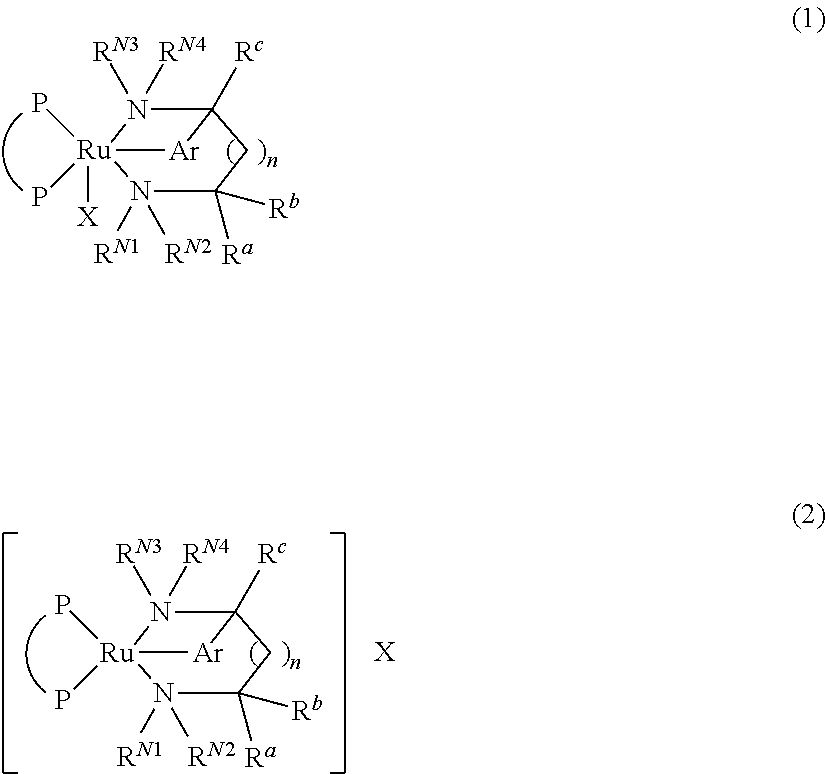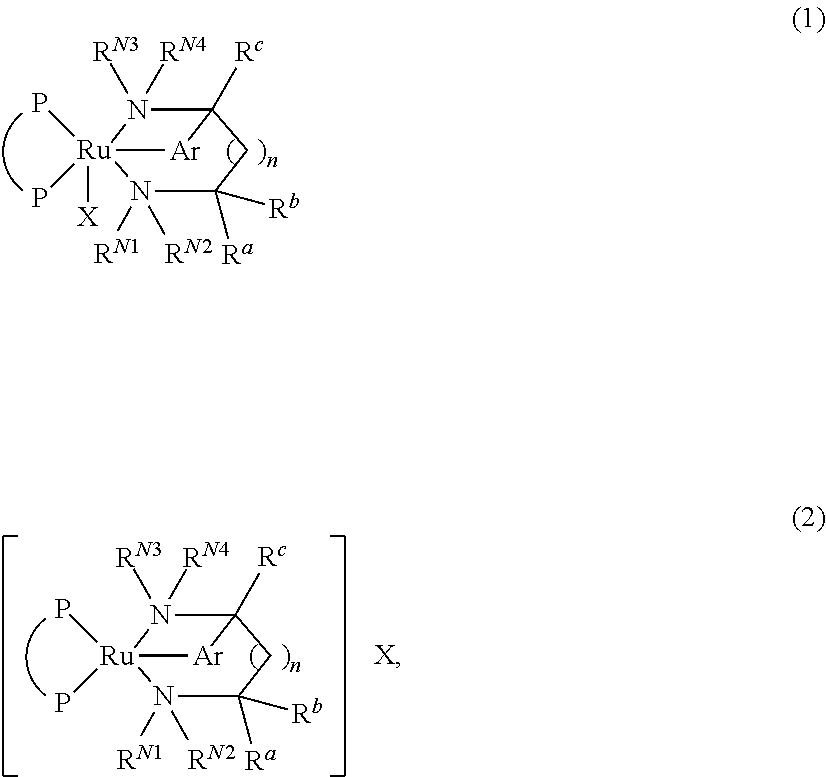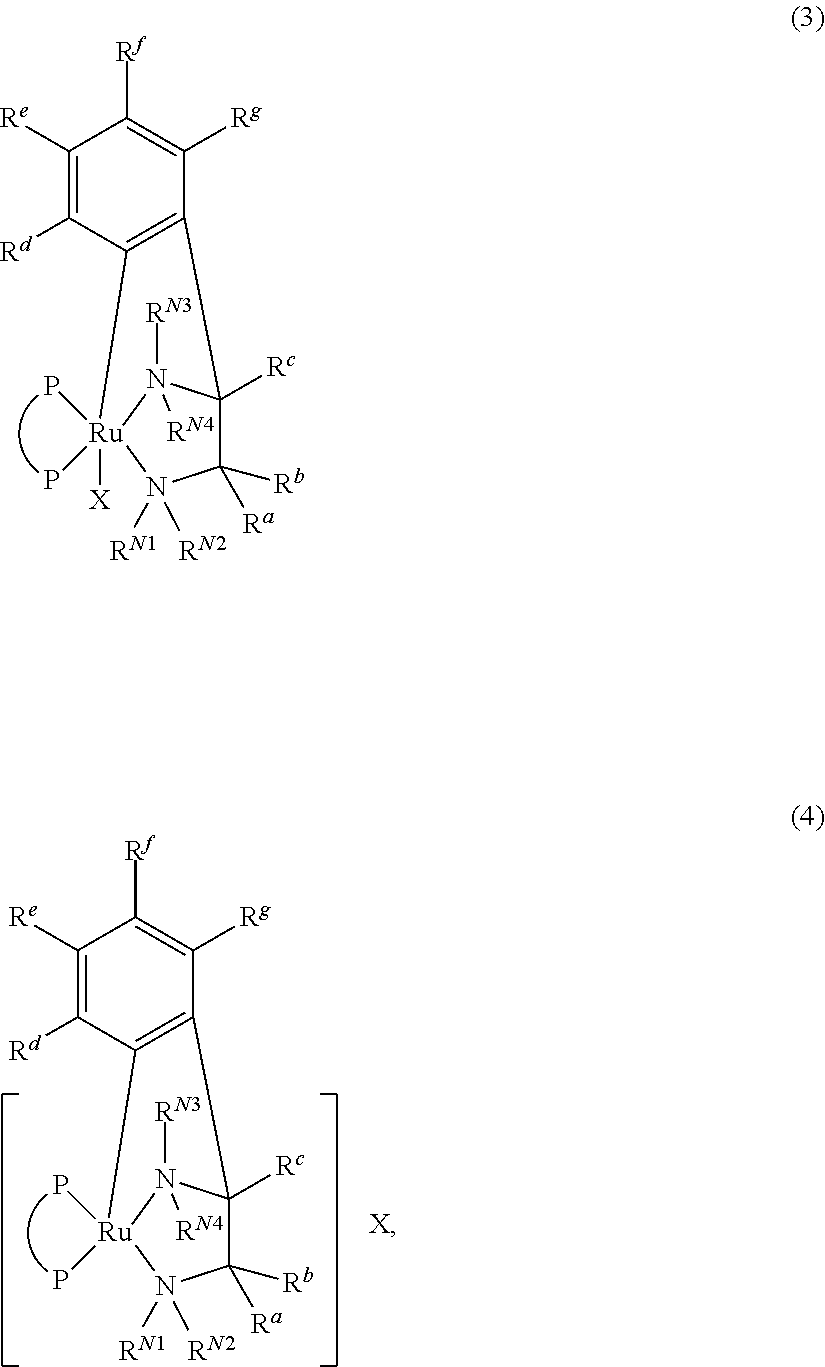Process for producing optically active amine
a technology of optically active amine and compound, which is applied in the direction of organic chemistry methods, chemical apparatus and processes, organic chemistry methods, etc., can solve the problems of loss of activity, difficulty in obtaining raw material substances, and the amount of desired compound cannot exceed the amount present before optical resolution, etc., to achieve excellent enantioselectivity, excellent optical purity, and excellent optical purity
- Summary
- Abstract
- Description
- Claims
- Application Information
AI Technical Summary
Benefits of technology
Problems solved by technology
Method used
Image
Examples
example 1
Asymmetric Hydrogenation of 2-Methylquinoxaline
[0105]
[0106]To an argon-purged pressure-resistant glass vessel (100 mL) equipped with a magnetic stir bar, RuCl[(R)-daipena][(R)-dm-segphos] (3.1 mg, 2.6 μmol) and KO(t-Bu) (14.1 mg, 0.126 mmol) were added, and the vessel was purged with argon again. To this vessel, a toluene (2.5 mL) solution containing 2-methylquinoxaline (355.4 mg, 2.47 mmol) and being degassed by the freeze-pump-thaw technique in advance was added by pressure transfer using a cannula. An operation in which hydrogen was introduced into the pressure-resistant vessel up to 0.8 MPa and then released was repeated 10 times to completely substitute the inside with hydrogen. Then, hydrogen was introduced up to 2.0 MPa, and the vessel was stirred in a water bath at 40° C. for 13 hours. After hydrogen was released, the solution was concentrated under reduced pressure, and the residue was purified through a silica gel short path column (hexane:ethyl acetate=1:1) to obtain (S)-...
example 12
Asymmetric Hydrogenation of 2-Ethylquinoxaline
[0110]
[0111]To an argon-purged pressure-resistant glass vessel (100 mL) equipped with a magnetic stir bar, RuCl[(R)-daipena][(R)-dm-segphos] (2.0 mg, 1.7 μmol) and KO(t-Bu) (9.2 mg, 0.082 mmol) were added, and the vessel was purged with argon again. To this vessel, a toluene (1.7 mL) solution containing 2-ethylquinoxaline (269.4 mg, 1.70 mmol) and being degassed by the freeze-pump-thaw technique in advance was added by pressure transfer using a cannula. An operation in which hydrogen was introduced into the pressure-resistant vessel up to 0.8 MPa and then released was repeated 10 times to completely substitute the inside with hydrogen. Then, hydrogen was introduced up to 2.0 MPa, and the vessel was stirred in a water bath at 40° C. for 25 hours. After hydrogen was released, the solution was concentrated under reduced pressure, and the residue was purified by silica gel column chromatography (hexane:ethyl acetate=5:1 to 3:1 to 1:1) to obt...
example 13
Asymmetric Hydrogenation of 2-(1-Propyl)quinoxaline
[0112]
[0113]To an argon-purged pressure-resistant glass vessel (100 mL) equipped with a magnetic stir bar, RuCl[(R)-daipena][(R)-dm-segphos] (1.6 mg, 1.4 μmol) and KO(t-Bu) (8.0 mg, 0.071 mmol) were added, and the vessel was purged with argon again. To this vessel, a toluene (1.4 mL) solution containing 2-(1-propyl)quinoxaline (238.5 mg, 1.38 mmol) and being degassed by the freeze-pump-thaw technique in advance was added by pressure transfer using a cannula. An operation in which hydrogen was introduced into the pressure-resistant vessel up to 0.8 MPa and then released was repeated 10 times to completely substitute the inside with hydrogen. Then, hydrogen was introduced up to 2.0 MPa, and the vessel was stirred in a water bath at 40° C. for 28 hours. After hydrogen was released, the solution was concentrated under reduced pressure, and the residue was purified through a silica gel short path column (ethyl acetate) to obtain (S)-1,2,...
PUM
| Property | Measurement | Unit |
|---|---|---|
| optical purity | aaaaa | aaaaa |
| optical purity | aaaaa | aaaaa |
| optical purity | aaaaa | aaaaa |
Abstract
Description
Claims
Application Information
 Login to View More
Login to View More - R&D
- Intellectual Property
- Life Sciences
- Materials
- Tech Scout
- Unparalleled Data Quality
- Higher Quality Content
- 60% Fewer Hallucinations
Browse by: Latest US Patents, China's latest patents, Technical Efficacy Thesaurus, Application Domain, Technology Topic, Popular Technical Reports.
© 2025 PatSnap. All rights reserved.Legal|Privacy policy|Modern Slavery Act Transparency Statement|Sitemap|About US| Contact US: help@patsnap.com



